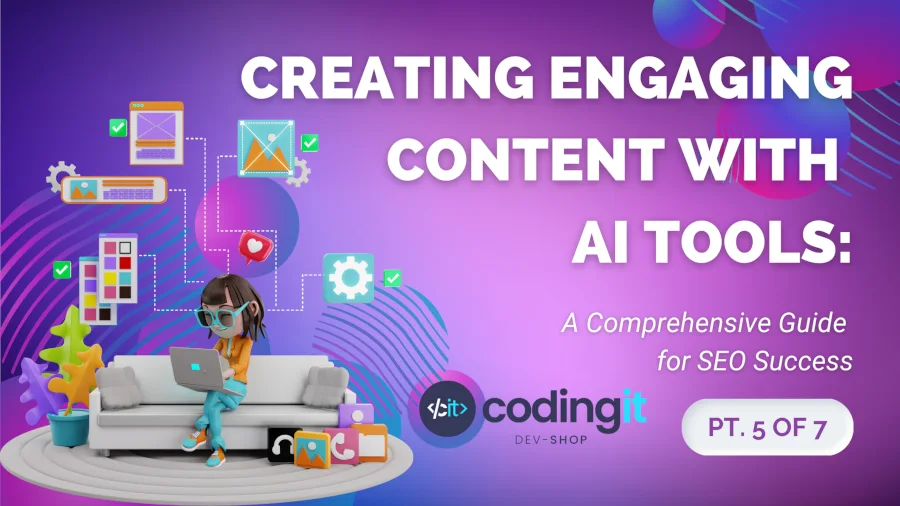Content creation has emerged as a pivotal element in the success of marketing and branding efforts. However, with the ever-increasing competition for online visibility, businesses must find ways to stand out amidst the noise and connect with their audience on a deeper level. This is where the power of artificial intelligence (AI) comes into play.
AI has revolutionized numerous industries, and content creation is no exception. By leveraging AI tools, businesses can unlock a world of possibilities, enabling them to create compelling, relevant, and SEO-friendly content that resonates with their audience. This article is designed to equip you with the knowledge and skills to harness the immense potential of AI in content creation.
By following the comprehensive guidance provided in this series of articles, this is only part 5 of the 7 part series, you will gain a deeper understanding of AI-powered content creation and its immense potential for driving organic traffic and user engagement. Equipped with practical knowledge and valuable insights, you will be empowered to leverage AI tools to create compelling and optimized content that sets you apart in the hyper-competitive digital landscape.
Now, let’s begin exploring the world of AI-powered content creation and unlocking the opportunities it holds!
- Personalizing Content with AI Tools
- Benefits of Personalization
- Challenges and Limitations
- Utilizing AI-Powered Chatbots for Interactive Content
- Implementing Recommendation Engines for Tailored Experiences
- Generating Dynamic Content with Natural Language Generation (NLG)
- Case Studies: Successful Personalization Strategies
- Regulatory Landscape: Be Prepared to Change
- Conclusion
Personalizing Content with AI Tools
In today’s digital landscape, personalization is the key to engaging your audience and providing tailored experiences. AI-powered tools have revolutionized content personalization, enabling businesses to deliver customized content at scale. In this chapter, we will explore how to utilize AI-powered chatbots for interactive content, implement recommendation engines for tailored experiences, generate dynamic content with Natural Language Generation (NLG), and showcase case studies of successful personalization strategies.
Benefits of Personalization
Personalization offers several benefits for both businesses and users. Some of the key advantages include:
- Improved User Engagement: Personalized content creates a more relevant and tailored experience for users, increasing their engagement with the content and the brand. By delivering content that aligns with users’ interests and preferences, businesses can capture and hold their attention more effectively.
- Increased Conversions: Personalization can have a positive impact on conversion rates. By delivering personalized recommendations or offers based on user behavior and preferences, businesses can provide users with more relevant options, increasing the likelihood of conversions and purchases.
- Enhanced Customer Satisfaction: Personalized content shows that a business understands and values its customers. By delivering content that meets users’ individual needs, businesses can enhance customer satisfaction and loyalty, leading to long-term relationships and repeat business.
- Higher Retention Rates: Personalization can contribute to higher user retention rates. When users receive personalized experiences that continuously meet their expectations, they are more likely to remain engaged and loyal to the brand, reducing churn.
- More Effective Marketing Campaigns: Personalization allows businesses to tailor their marketing messages and campaigns to specific user segments. By delivering targeted content to the right audience at the right time, businesses can improve the effectiveness of their marketing efforts and achieve better results.
Challenges and Limitations
While AI-powered personalization offers significant benefits, there are also challenges and limitations to consider:
- Bias in Recommendations: AI algorithms can inadvertently introduce bias into personalized recommendations if not carefully designed and monitored. This can result in recommendations that reinforce existing preferences or stereotypes, limiting diversity and discovery.
- Overreliance on Algorithms: Relying solely on algorithms for personalization can overlook the importance of human judgment and creativity. Algorithms may struggle to understand complex nuances or context that humans can grasp, potentially leading to suboptimal recommendations.
- Potential Pitfalls of User Behavior Data: Personalization based solely on user behavior data may not capture users’ true preferences or account for their evolving tastes. It is important to consider other factors, such as explicit user preferences or demographic information, to create a more comprehensive and accurate personalization strategy.
- Need for Ongoing Human Oversight: Human oversight is crucial to ensure the quality and accuracy of personalized content. Continuous monitoring, evaluation, and refinement are necessary to address any issues, biases, or unexpected outcomes that may arise from AI-powered personalization.

Utilizing AI-Powered Chatbots for Interactive Content
AI-powered chatbots have gained significant popularity as a versatile tool for delivering interactive and personalized content experiences. These chatbots are capable of engaging users, answering their queries, and providing real-time information in a personalized manner. Let’s delve into the various ways you can effectively leverage chatbots:
Customized Recommendations: Tailoring Content to User Interests
Chatbots equipped with AI algorithms can analyze user preferences, browsing history, and interactions to offer highly customized recommendations. By understanding users’ individual preferences and behaviors, chatbots can suggest content that is relevant and aligned with their interests. This personalized approach enables users to discover new and engaging content tailored to their specific preferences, enhancing their overall content experience.
Interactive Storytelling: Engaging Users through Narrative Experiences
One of the compelling capabilities of AI-powered chatbots is their ability to guide users through interactive storytelling experiences. By incorporating branching dialogue options and interactive elements, chatbots allow users to actively participate and shape the narrative. This dynamic and immersive content journey creates a highly engaging experience, where users feel involved and emotionally connected to the content. Interactive storytelling through chatbots provides a unique and captivating way to deliver personalized content.
Personalized Assistance: Enhancing User Experience through Virtual Assistants
Chatbots can serve as virtual assistants, providing personalized recommendations, answering user questions, and offering tailored support based on individual needs. By leveraging AI algorithms, chatbots can understand user preferences, context, and historical interactions to deliver assistance and recommendations that align with users’ specific requirements. This personalized assistance enhances the user experience, saves time, and builds a stronger connection between the audience and the brand.
Example:
To illustrate these techniques, consider a travel website that employs a chatbot to interact with users. When a user engages with the chatbot, it can intelligently ask questions about their preferred destinations, travel dates, and interests. Based on the user’s responses, the chatbot utilizes AI algorithms to generate personalized travel itineraries, recommend attractions, and suggest nearby restaurants or accommodations that cater to the user’s specific preferences. This interactive and personalized approach creates a seamless and engaging travel planning experience for the user.
By effectively utilizing AI-powered chatbots, businesses can provide users the opportunity to have a deeper connection with them, if done well. If done poorly, the trust that can be eroded can be very difficult to get back.

Implementing Recommendation Engines for Tailored Experiences
Recommendation engines powered by AI algorithms have revolutionized the way content is personalized and delivered to users. These engines leverage advanced techniques to analyze user behavior, preferences, and historical data, enabling the provision of highly personalized recommendations. Let’s explore the different approaches used in recommendation engines:
Collaborative Filtering: Uncovering Patterns in User Behavior
Collaborative filtering is a popular technique that analyzes user behavior and preferences to identify patterns and make recommendations based on similar users’ tastes. By comparing a user’s behavior and preferences with those of other users, the recommendation engine identifies items that users with similar tastes have shown an affinity for. For instance, streaming platforms employ collaborative filtering to suggest movies or TV shows based on what similar users have watched and enjoyed. By leveraging collective user data, collaborative filtering enables the discovery of content that aligns with a user’s interests but may not have been discovered otherwise.
Content-based Filtering: Analyzing Content Attributes for Recommendations
Content-based filtering focuses on analyzing the attributes and characteristics of the content itself to make recommendations. The recommendation engine matches user preferences with specific content features, such as genres, keywords, or themes. For example, an e-commerce website can recommend products based on a user’s previous purchases or browsing history, considering attributes like product category, brand, or specifications. Content-based filtering is particularly effective in situations where user data is limited, as it relies on the inherent characteristics of the content to generate recommendations.
Hybrid Approaches: Combining User Preferences and Content Attributes
Hybrid approaches combine collaborative filtering and content-based filtering techniques to provide more accurate and diverse recommendations. By considering both user preferences and content attributes, hybrid recommendation engines offer a comprehensive personalized experience. These approaches take advantage of the strengths of each method to overcome limitations and deliver refined recommendations. For example, a hybrid recommendation engine for a music streaming service may consider a user’s listening history, favorite genres, and similar users’ preferences, while also taking into account factors such as music genre, tempo, artist collaborations, and lyrics. By combining user preferences with content attributes, the engine can offer highly relevant and personalized song recommendations that align with the user’s unique taste.
Example:
To illustrate these techniques, let’s consider a music streaming service that utilizes a recommendation engine. The recommendation engine analyzes a user’s listening history, favorite genres, and the preferences of similar users to identify patterns and make personalized song recommendations. Simultaneously, it takes into account various content attributes, such as music genre, tempo, artist collaborations, and lyrics. By combining these factors, the recommendation engine can deliver a tailored music experience, suggesting songs that align with the user’s musical taste while considering specific content features that contribute to their preferences.
Implementation Tips and Best Practices:
To successfully implement AI-powered personalization, businesses can follow these practical tips and best practices:
- Ensure Data Quality and Management: High-quality data is essential for accurate personalization. Implement robust data collection, storage, and management practices to ensure data integrity and privacy compliance.
- A/B Testing: Conduct A/B testing to evaluate different personalization approaches and determine what resonates best with users. Test various algorithms, recommendation strategies, and content variations to optimize personalization efforts.
- Segment Audiences: Segment users based on relevant attributes such as demographics, preferences, or past behaviors. This allows for more precise personalization, targeting specific user segments with content tailored to their needs.
- Use Contextual Information: Incorporate contextual information, such as location, time, or device, to enhance personalization. Contextual factors can further refine content recommendations and improve the overall user experience.
- Align Personalization with Marketing and Business Goals: Ensure that personalization efforts align with broader marketing and business objectives. Personalization should serve a purpose, whether it’s driving conversions, increasing engagement, or improving customer satisfaction.
By implementing recommendation engines that utilize collaborative filtering, content-based filtering, or hybrid approaches, businesses can deliver highly personalized recommendations, enabling users to discover new and relevant content tailored to their individual preferences and interests.
Generating Dynamic Content with Natural Language Generation (NLG)
Natural Language Generation (NLG) is an advanced AI technology that empowers businesses to create dynamic and personalized content. NLG systems possess the capability to analyze data inputs and generate human-like narratives, reports, or descriptions. Let’s delve deeper into how NLG enhances content personalization:
Data-driven Storytelling: Creating Personalized Narratives and Reports
NLG excels at analyzing extensive data sets and transforming them into engaging narratives and reports. By extracting insights from the data, NLG systems can generate personalized content tailored to specific user segments or individual needs. Businesses can leverage NLG to create data-driven stories that deliver relevant information to users in a compelling and easily understandable format. For instance, a news platform can use NLG to automatically generate personalized news articles for readers based on their interests and preferences.
Personalized Product Descriptions: Tailoring Content to Individual Preferences
NLG can be harnessed by e-commerce websites to generate unique and persuasive product descriptions that cater to each user. By analyzing user preferences, purchase history, and demographic information, NLG systems can dynamically generate product descriptions that highlight features and benefits that align with the individual’s specific needs. This personalization creates a more engaging and persuasive product experience, enhancing the likelihood of conversions and customer satisfaction.
Automated Email Marketing: Tailoring Email Content in Real-time
NLG finds significant application in automating email marketing campaigns and personalizing email content. By leveraging user behavior, interests, and purchase history, NLG systems can dynamically generate subject lines, introductory paragraphs, and product recommendations for each recipient. This real-time personalization of email content improves engagement, increases open and click-through rates, and enhances the overall effectiveness of email marketing efforts.
Example:
To illustrate the power of NLG in personalization, consider a financial institution that utilizes NLG to automatically generate personalized investment reports for its clients. The NLG system analyzes client portfolios, market data, and investment strategies to generate customized reports that provide comprehensive insights, recommendations, and future projections aligned with each client’s financial goals and risk appetite. The generated reports are tailored to the specific needs and preferences of each client, ensuring that they receive relevant and actionable information to make informed investment decisions.
NLG enables businesses to scale their personalization efforts while providing users with content that is specifically tailored to their individual preferences and needs. What’s not to like about that?

Case Studies: Successful Personalization Strategies
Here are a few real-world case studies to help drive the point home:
- Amazon: The e-commerce giant employs sophisticated recommendation engines that analyze user behavior, purchase history, and browsing patterns to deliver highly personalized product recommendations. This has contributed significantly to Amazon’s success in cross-selling and upselling. You didn’t think that the ‘Commonly Bought Together’ section was there just to help you, did you?
- Spotify: By utilizing collaborative filtering and analyzing user listening habits, Spotify creates personalized playlists and Discover Weekly recommendations, tailoring the music experience to individual preferences. This personalization strategy has played a crucial role in user retention and engagement. No one wants the mood killed by an errand song selection, so why not rely on the user population to help us make sure that this doesn’t happen to you?
- Netflix: With its recommendation engine, Netflix analyzes user viewing history, ratings, and interactions to generate personalized movie and TV show recommendations. This personalization strategy has increased user satisfaction and prolonged viewing sessions. Surely, they are being honest about the top 10 recommendations for your geographic area, right? Not just showing me things that others who have my taste find acceptable.
Regulatory Landscape: Be Prepared to Change
It is essential to understand the regulatory landscape and adhere to relevant regulations and industry standards when implementing AI-powered personalization. There can and will be severe ramifications if you choose to overlook these regulations, so that them seriously!
Consider the following:
Privacy Regulations
Familiarize yourself with privacy regulations such as the General Data Protection Regulation (GDPR) in the European Union or the California Consumer Privacy Act (CCPA) in the United States. Ensure that personalization efforts comply with these regulations regarding data collection, usage, and user consent. Do you reside in a state or country that limits what data you are allowed to collect and how that data can be utilized?
Ethical AI Usage
Follow ethical guidelines and best practices for AI usage. Stay in the conversation by following relevant blogs, news publications, and popular AI forums to get an understanding of these issues and their relevance to your business. Some principles like transparency, fairness, and accountability in personalization algorithms and decision-making processes should be thoroughly understood to ensure your usage is within the bounds of the law and what we, as a society, deem as acceptable use.
Industry-Specific Regulations
Some industries, such as healthcare or finance, may have specific regulations or standards regarding personalization. Understand and comply with any industry-specific regulations to ensure legal and ethical practices.
By addressing these additional sections, the article provides readers with a more comprehensive understanding of the benefits, challenges, and best practices associated with AI-powered personalization, as well as the regulatory considerations that businesses should keep in mind.
Conclusion
In conclusion, AI-powered tools have transformed content personalization, enabling businesses to deliver tailored experiences at scale. From AI-powered chatbots to recommendation engines and NLG, businesses can engage users, increase conversions, and enhance customer satisfaction. But the journey doesn’t end here!
Stay tuned for Part 6 of our series, where we delve into the exciting world of Analyzing and Optimizing AI-Generated Content. Discover how data-driven insights can further refine and improve your personalization strategies. Get ready to unlock the full potential of AI in content personalization. Don’t miss out!
